2000
It is the year 2000. I just turned 34 years old, Oslo just turned 1000 years old. In the middle of March, having just told an assembly of colleagues that "if you want to reach for the stars, you should build a rocket rather than wait for the sky to fall on your head", I find myself sitting on some steps, a short distance from our college, staring into the deep blue sky, perhaps waiting for it to fall on my head, but at least warming myself in the hot, lazy spring sunshine. It's time to get back to the office, but as I rise, I feel a sudden drop of icy cold run down my neck. I turn from the spotless blue backdrop of Norwegian spring to a black doomsday cloud, filling half the sky like something from a Frank Herbet book. It looms heavily overhead spitting snowflakes which soon engulf the steps where I was sitting. It is snowing now. This is the Oslo spring. A tapestry of contradictions.
This last year has been a tough one. I have been working harder than ever, I have written a book which consumed last year's summer holiday and have been developing and teaching new courses which have almost killed me. In addition it seems that I am dragged ever further into political and administrative functions which depress me greatly. I have always hated conflict, but sometimes conflict is the only way to solve a problem, and politics is all about conflict. I envy my students their freedom and feel as though I am slipping ever further into an adult world where I don't belong. I have never been more ready for a vacation than this summer.
Vacation this year coincided with the wedding of friends Marit and Tai, in the Bay Area of the United States (San Francisco). My friend from Oslo, Nils, decided to plan a trip around the wedding, with arrangements to meet an ex-Oslo friend Susanne, and two other friends Claudia and Steinar (from Germany and Norway) along the way, and travel part of the way with them. At about the same time I was invited to be part of the SAGE certification committee (a committee to decide standards for system administrators in the computer industry), who were meeting in Seattle just before the wedding. Since Seattle is run a plane's throw from San Francisco, With that, the travel plans clicked and Nils and I set off for Seattle at the end of July. Our route was to be Washington, California, Utah, Nevada and back to California. After Seattle, we would meet up with Susanne and Steinar in San Francisco, for the wedding. After the wedding in San Francisco, Nils, Susanne and I would fly to Salt Lake City where we would meet Claudia and her boyfriend Werner, who had been to a meeting on mathematical biology. There we would rent a car, drive around Utah national parks and end up in Las Vegas. From there we would fly back to the Bay Area and stay with Marit and Tai in Berekely.
USA: The land of three letter abbreviations (TLA). Forget about language, its redundant. Today its just CEO's talking about IPO's and dot coms on their way to SFO, driving their SUV's or 4x4s or even going EVA from their RV's. Does anyone have the feintest idea what they are talking about? Three letters seems to be the linguistic attention span of contemporary America, probably since that is all there is time to say in a TV show between commercials...
Getting to the US turns out to be a three legged journey and a long process, flying via Heathrow London, to Vancouver Canada, and then a short flight across the border to Seattle. Actually, Vancouver airport turns out to be worth the visit, nicely decorated with Indian carvings and attractively decorated. We have to clear US customs and immigration here in Vancouver before our connecting flight.
We arrive in Seattle and make our way by bus to the Madison Renaissance hotel, where the meeting is to be held. Even though we have only flown for half an hour from Vancouver to Seattle, the difference between Canada and the US is glaringly obvious. While Canada is modern and clean, the US looks dated and shabby. The airport bus could have come straight out of the 1970s, with its fake plastic wood panelling (which America was apparently fascinated with a some point in its recent history) and matted seats. It takes off into a dull concrete spaghetti of roads which eventually expel us onto the freeway heading towards Seattle. On the left, we pass the Boeing works and the Museum of Flight (where last year's LISA reception was held in its impressive interior). Along the way, I look for some sign of the dark side of a demonic possession, perhaps a twisted house struck by lightning. Doesn't Bill Gates live here somewhere? There is no sign of the Microsoft cooperate empire, no cauldron of hellfire that I can see. Just as well perhaps.
The bus drops us off at the hotel, a moderate skyscraper next to the freeway, not far from the small centre of Seattle, and we are finally in coffee county. Seattle is the home of America's coffee revival: Starbucks and Seattle's Best Coffee. There is at least one coffee shop on every street. This will prove useful in the days we are here.
Seattle is, of course, the home of the famous Space Needle, a viewing tower with restaurant which resembles a flying saucer on stilts. Now a new museum has opened next door which is more interesting. A local millionaire has created a museum of music: the EMP, a TLA which means Experience Music Project. It is a huge and fascinating building built of strange curves and colours inspired by shapes and colours of electric guitars. Inside, one can see a plethora of memorabilia mainly from pop music history, and visit the interactive laboratory where it is possible to experience making music with electronic instruments, mixing records or make a music video. On the way home we eat at the excellent restaurant Fandango in Belltown.
The meeting I am here to attend is informative but unfocused and not very productive. At the end I am left with the depressing feeling that the certification effort might not quickly achieve the goals it needs to achieve in order to be successful. Perhaps it is just my general fatigue. I put it out of my mind, and focus on the pleasure of meeting old friends from USENIX and my friends George and Elaine, who live in Seattle.
America is a barrel of contradictions. Huge skyscrapers tower up, flaunting their gleaming perfection, bound together by busy clouds of shining cars---but all around is a shabby, third world chaos of ram-shackle, higgeldy piggeldy solutions; power cables looped in cats cradles, haphazardly bolted onto randomly dilapidated buildings, huddled together with a third-world feel. But America is also a wonderland of astonishing natural beauty and impressive achievements. From the almost Norwegian forests of Washington, the vegetation thins south of Mount Rainier and trees make way for a virtual desert. Flying towards San Francisco, it is like flying over an alien landscape. Reds and oranges, fill the desert like martian dunes, while thin fingers of bushy forest spread like varicose veins through the gullies of the desert mountain ranges. In the Bay itself, on the river flats, more brightly coloured, geometrical regions stand out as though they were fields of some fluorescent crop. Perhaps they are salt flats, similar to those we will see later around Salt Lake.
San Francisco airport (SFO) is a disaster. SFO is an SOB. It jam packed with people coming from flights and selfish crowds waiting to meet people coming from flights. Our baggage seems to be missing from the flight, but arrives long after the flight number has disappeared from the baggage claim boards. A taxi ride to the edge of Chinatown places us in a cheap but comfortable hotel called the Grant Plaza, on the corner of Grant and Pine. San Francisco is a city of hills and districts. Elevation seems to correlate well with wealth. The higher up one is, the better the view and the less likely one is to be beneath the infamous San Francisco fog (we argue whether it is really fog or low cloud, and the best explanation I can find for calling it fog is that FOG is yet another convenient Three Letter Abbreviation for low cloud).
China town seems to be a tourist trap, but it is reputed to be the second largest Chinese community outside of Asia, so it is not that easily dismissed. Not everyone speaks English (or even American) here. It reverberates with the sound of cheap gizmos (I swear that if I hear tweeting bird song one more time....) and souvenirs until late evening, but there is good food and it is possible to barter for cameras and CD players, or even film if you watch for the sell-by date. We have some good meals here, while Nils is sick at the hotel, watching TV.
American television is impossible to watch. It really is a tasteless cacophony of irrelevant sound and vision. Patronizing voices schedule maybe two trite, content-free sentences before they say: "I'll be right back" and they cut to yet more commercials. If it weren't so offensive, it could be fascinating how much production effort must be expended to produce something so totally void of merit. The abuse of music is also offensive: there shall be no silence on American TV. Even political speeches are phrased like advertisements, using voices like bad actors to explain in idiotic terms and three letter words to push nauseatingly puritan opinions about so-called "morality" as though it were obvious fact. I haven't felt so talked-down to since I was in primary school. Everyone is trying to make little sentimental stories of real life people (families!): back in the old days...Mary's life was... and your kids can't....until: she buys XYZ breakfast cereal which changes their whole family's existence. Please!
The US shares one thing with Norway, a byproduct of nationalism. Having grown up in England, I am used to phrases like "everyone" and "the public". But here, it is "All Americans" or "All Norwegian-s", a telling selectivity which smells of self-importance.
A chilly breeze. The crescent moon hangs in a cloudless sky; rumbles of traffic wax and wane ceaselessly, like the ocean, ever present and enveloping. A street car rumbles past on a 15 degree slope. A tapered tower, a spire of commerce thrusts hundreds of feet upward, threatening to impale the moon. Chinatown, San Francisco from the corner of Grant and Pine. The wedding at the Norwegian sea-man's church goes well and we have a great evening at the reception which is held not far from the hotel at a Chinese restaurant, sharing a table with some good humoured friends of the happy couple. The wedding is deftly managed like a TV game show by Tai's sister, and we slurp, chew and gobble down eight dishes of Chinese food before the cake is cut. (Thankfully the Chinese make better cakes than the Americans: for me a meal is not finished until I have had something sweet.) By the time we get to the eight dish (fish) I am not quite sure what to do with the food. My Portuguese neighbour points to the fish and cries "Flounder!" I cry: "I am!". One person understands my joke, which is better than average! The wedding evening seems to pass in surreal blur of colour and multiple dresses. The speeches are entertaining, even when in Chinese (which is a language with much musicality and subtle but beautiful tones). By the end of the evening, the bride is looking less shell shocked and more relieved. We retire and sleep well.
The next day, we struggle to pack for the desert, exorcizing wedding clothes into separate baggage to be left behind. Somehow, the baggage seems to have expanded. Still somehow it gets done and we are ready to go. Just as we are about to leave, the street outside erupts in a procession of drumming and Chinese dragons -- a demonstration of support for a governor or politician. As the tail of the dragon recedes down Grant, we grab a cab and head for Oakland airport.
On the plane to Salt Lake City, we are placed in a single row of backward facing seats opposite a couple who are wedged firmly in place by a huge, obese man who seems to radiate enough nervous energy to power the aircraft. I could fall in love withe air-hostess, despite the badly fitting, unflattering uniforms of Southwest airline. I love the good-humoured California accent and the irony with which we enacts the safety demonstration in perfect concert with the two other attendants further down the plane. It looks like an exercise in synchronized swimming: first the breast stroke with two exits at the rear of the plane, two over the wing and two at the front... Now we do the over-arm crawl to show the emergency lighting strips, all to the sound of a gasping rendition of the safety instructions, with all the high speed charm of a teleprinter, rattling out instructions without pause in a single breath. All this and the passengers are quite unmoved.
Sitting backwards on an aircraft is a hairy experience as the plane takes off. As the plane angles up, we seem to be weightless, falling from the seats towards the incredible hulk sitting in the seat opposite. Each turbulent bump, forces the seat-belt into our already wobbly stomachs. Never mind, if we throw up, it will only anoint three innocent bystanders...
Streaks of civilization stretch out across the flat plains between Oakland and Reno. From this height they look like images of Mayan gods, or perhaps signals to passing space travellers. Roads carve lines into the otherwise featureless desert, like the spiders and monkeys of Mexican plateaus which tell of the central characters in their culture. But the only thing these lines seem to be saying is "COMIN' THRU!"
The diversity of the landscape is baffling. A strict agriculture makes way to mountains and lakes, more like Norway here. The sky is clear. A lone cloud floats below like a bubble on the wind. Suddenly a spaghetti of roads cut through a pine forest and begin to resemble the Mayan figures more closely. I would look closer, but the plane jolts emptying an ice drink into my crotch. The thermals around Reno make this ride a painful study in balance. The landscape has changed from desert to mountains and back just on this short flight. Coming into Salt Lake city we see huge salt flats overshadowed by great mountains. As the plane descends, we actually feel temperature rise in the cabin. Stepping out of the aircraft is stepping out of the frying pan... The heat hits us, like walking into an hot exhaust from a jet engine, but it doesn't stop. Thank goodness for air conditioning.
We are met my friends from Germany who have been staying here for a conference in mathematical biology. We collect our rental car, which was to be a small family car, but it turns out that the girl who expedites the cars is a Norwegian and she rewards us with a huge 4 wheel drive Mistubishi with plenty of luggage space at no extra cost. If it weren't for the automatic transmission I could love with a car like this!
Our German friends have a girlfriend, Brynja, whose family owns a `cabin' in the mountains just fifty miles from Salt Lake City in Midway/Heber City. It is a beautiful A-frame designer house, clad in corrugated, galvanized metal. We arrive as thunderclouds cast a light spray from the heavens. Hardly rain, but it helps to cool the air to a manageable temperature. The "cabin" is a dream. With windows on two sides, its elegantly carpeted interior provides a stunning view down into the valley. Inside it is an IKEA paradise of metals, glass and white paint and comfortable furniture. On the balcony, grasshoppers serenade us and moths provide the ballet. After the concrete oven of Salt Lake City, this is an idyllic ending place for the day's journey. IT's hard to believe that we were in urban San Francisco only a few hours earlier. I find myself wondering about Brynja's name, which is apparently Icelandic. Could it mean `well'? Well...she is not a well woman. She doesn't like wells and she doesn't like fetching the water. Never mind, I'll probably never learn the origin of the name out here.
The next day, we drive up to a national park nearby to take a
short hike, while Nils lies sick in the car. He picked up something on
the flight over which has been brewing for several days and a hike in
this altitude (about 3000m) doesn't help. The trail is a forest hike
past a bunch of lakes. It even has a name which I can't remember
exactly: something like `bunch of lakes'. The trail is easy climbing,
but I puff and pant like I'm in lousy shape, until someone reminds me
about the altitude and the ego reflates, if not my lungs.
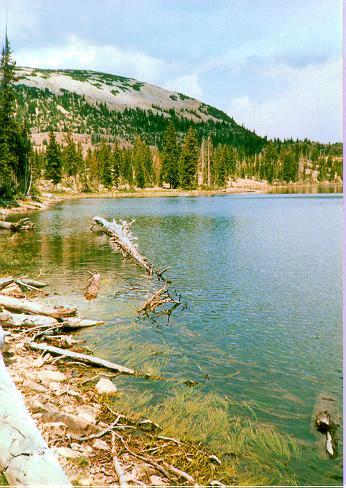

At one point, the air is so thin that I totally inflate and float up
like a balloon just above Susanne, Claudia and Werner. They
look a little surprised:

Susanne threatens to jump from a cliff,

so I deflate, and we just climb down instead. Later we return past
Midway to the town of Provo, where we meet with Brynja this time in
her family home: yet another attractively designed house in the town,
full of bedrooms and bathrooms. We spend the night here on our way to
the canyon lands.

The road to Moab is even more astonishing than the flight to Salt Lake
City. This state is a geological treasure trove. Red iron hills turn
suddenly to dusty grey powder.
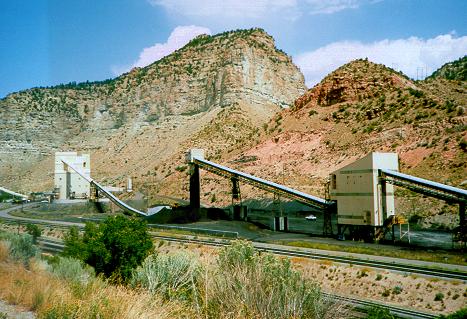

High mountain stacks, colo(u)rfully
layered are mined for coal, to flat desert. The scale of it all is
surely unparalleled in Europe. The mountains have the appearance of a
trifle (layer cake) which have been munched away at random, rather
than sliced. Sometimes the bites are deep, revealing many layers,
sometimes shallow. But the layers are always visible, eroded through
what looks like weak sandstone to harder rock.
On the way, we read of a ghost town: a town abandoned during the
1950's and decide to make a slight detour to see it. There are Indian
Anasaze writings on the rock there too, some 4000 years old.
First we
arrive at Thompson, which is not a ghost town, but seems not far from
it.



We stop conveniently at the town's single crossroads where an
abandoned motel is hosting various animals and a few spare rooms. No
one is in sight. A still-functional railway crossing chimes
relentlessly, its red lights flashing for a train which never arrives;
perhaps a ghost train? A hot wind blows dust across the crossing to a
little shanty like enclosure of caravans which seem to have been
recently occupied. This is not glamour central. Over the crossing,
along a dirt trail, there are crumbling sandstone rocks in a small
canyon adorned with cave paintings.

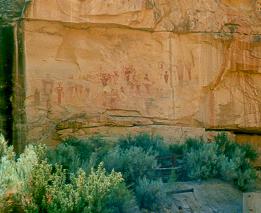
The baking heat, amplified by the
re-heating of the enclosed crumble cake canyon rocks is truly
oppressive. Only a few bushes and grasses grows here. It is difficult
to understand how anyone could survive. A little further along, we see
the abandoned remnants of the ghost town. These are just shells of
earlier constructions. No ghosts, nothing to see. Move along.
In Moab we find a hotel, only a few metres from the Visitors
Information Center. It is an unobtrusive building called the Off
Center Hotel.

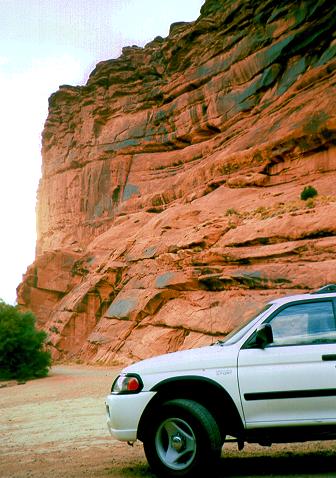
The cheap exterior belies a concept hotel run by a
couple of gents who clearly have this as a labour of love. Each room
is decorated according to a different theme: there is a Victorian
room, a miners' cabin, an aquarium, a wave room, a mountain
cabin... We have a choice of the rustic cabin and a couple of others,
and end up with the minors cabin. It is equipped with two double beds,
slatted wooden panelling (like a wooden cabin), a stone chimney (in
which a colour television replaces the oven). A 1920's typewriter and
a bureau full of old books sits in one corner of the room and other
artifacts such as a gold sieve, a sledge and a miner's helmet decorate
the room. From the corrugated iron ceiling, two miners lamps
illuminate the room and an over exerted air conditioner blows cool air
through what appears to be a leak in the roof. The bathroom is down the
hall, but then the room only costs $26 per night.
Just around the corner in the same building, next to the hotel, is a small breakfast and lunch cafe called Breakfast at Tiffany's. Like the hotel, it is decorated with every manner of collected artifact. An Etch-a-sketch, a Jack-in-the-box and some other stranger toys decorate our table. Around the walls are dozens of books and pictures, including pictures of Holy Golightly from the movie version of Breakfast at Tiffany's. A pencil thin Ukrainian waitress of maybe 20 years, with a clunky brace on her otherwise perfect looking teeth, stresses back and forth apologizing the long delays to breakfast with her 70% American accent. Breakfast takes forever, they are so under-staffed today, and it has been quiet for weeks and now a sudden rush...and she's so sooorrrry! If she weren't so helpless, the wait could be very annoying; instead, I have only the desire to hug her and say `There there...it's okay'. She's trying so hard, but some people can only try...
We drive out to Canyonlands national park from Moab up a windy road which splits into different areas of the Canyonlands. We begin with The Upheaval Dome. This is what (from the air) appears to be a crater in the iron red sandstone, into which `copper carbonate' green intrusions burst forth in a kind of dome shape, presumably due to the upheaval of the impact zone. No one is quite sure how this feature formed, but it is spectacular and it makes a nice short hike in the oppressive heat.
Our second destination is the Island In The Sky, a lookout point
across the impressive expanse of the canyons. As one looks out across
the features, it is easy to see how they were formed from the erosion
of the layered rock. Soft rock on hard rock on soft rock...the soft
rock has been eaten away and the hard rock has endured, sheltering the
soft rock underneath. Gradually as rivers and cracks lead to erosion
one is left with flat beds of hard rock, and boulders of hard rock
supported by towers of softer layers. This chisels out the great stacks
which poke up like the fingers of someone who sank into the sand, or
perhaps effigies of gods, staggered by the heat. As I look out across
this red rock canyon, I cannot help but wonder whether this is what
the planet Mars looks like. But for the blue sky, this could be an
alien world.

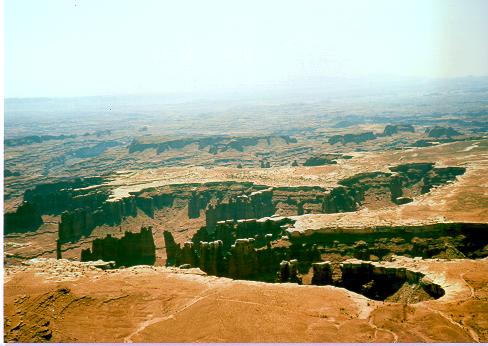
Back at the hotel, we change rooms. This time, the wave room: the walls are mottled turquoise on one side, pink on the other, with a blue wave running around at head height. The ceiling is lemon yellow, with scarlet coving and yellow skirting boards meet the turquoise carpet. Two tropical fish stare at us from a largish fish tank.
The next day we ask the information centre for a lake or river where it is possible to swim. Apparently one does not swim outside of artificial pools here, but they tell us of a place called Ken's lake, just four miles out of Moab, so we set forth and dive out to see the place. Ken's lake turns out to be am almost parched quarry with a a few feet of water in the bottom. If any place could be less idyllic, it would have been an impressive achievement. We choose not to clamber out across the rocky `beach'. Instead we sight a waterfall far off up the side of the valley walls. A dirt track seems to lead up the side of the valley, so we engage the four wheel drive and chug up the track. The road is bumpy and slow going, but we make it up, in spite of the automatic gears (which never seem to be in the gear that I would like them to be in), and in spite of the fact that I have forgotten to release the handbrake. Oops. As we reach the top there is a nice view of the valley, but no waterfall. The track descends the other side into a small creek, and we follow it down an even steeper and bumpier section until we find a small stream dam. Here we park the car and climb eagerly down to the clear steam, where we paddle and bathe as dark thunderclouds gather on the other side of the sandstone, pumpkin-pile rocks. This is real western country. Any minute John Wayne gonna ride out of them thar hills, shot at by injuns.
We trudge into the stream, barefoot at first, then later with sandals. The water is warm and soothing and there is shelter here from the stream's little entourage of shrubs and trees and grasses. As we splash downstream, I recall the last time I did this in a geography field trip in school, where we tested the empirical rule that the distance between riffles (rapids) and pools (deeper sections) is always 5-7 times the width of the river. I estimate about 5 for two points of measurement and feel satisfied that science works here too.
From Moab, we drive south towards Monument Valley around lake Powell.
This is a bold line through a striking desert, with roads which seem to
stretch off forever into the horizon. If Canyonlands reminded me of Mars,
then I have surely seen Mars now.
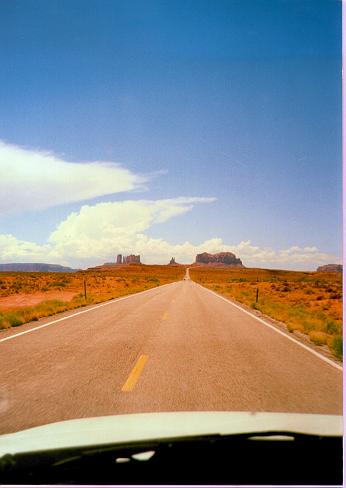
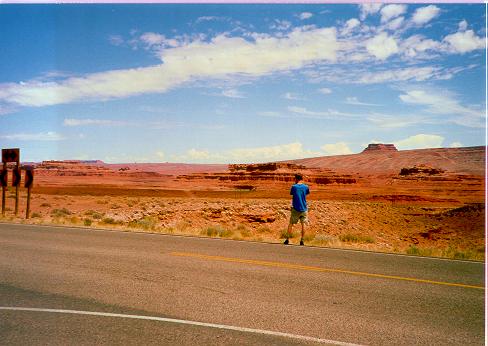
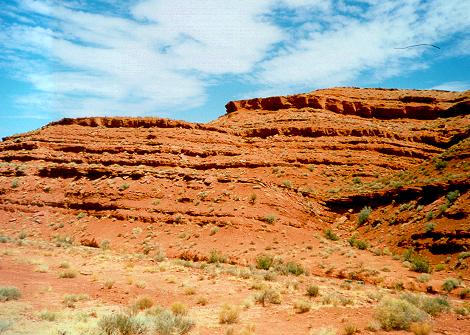

It is impossible to describe the subtle
changes in geology which spring up around every corner. I have never seen
so many geological features, so many variations on the theme of red rock.
We want to stop and take pictures every hundred yards, but pictures would
not capture the scenes. Suddenly:
Welcome to the Navajo nation! The Navajo
(Navaho) Indians still live here on their huge reservation, and are
occasionally visible selling souvenirs along the roadside, flagged
with their own version of the stars'n'stripes, or driving huge pickup
trucks from camp to camp. It is almost inconceivable that anyone could
live here in such a parched wilderness, red skin or not, but this is
without doubt a wondrous place of powerful images. It is not hard to
understand the Indian fascination with powerful symbols or the animals
which survive under such pressure. "Yaa'aa'tey, Navajo": it is good.
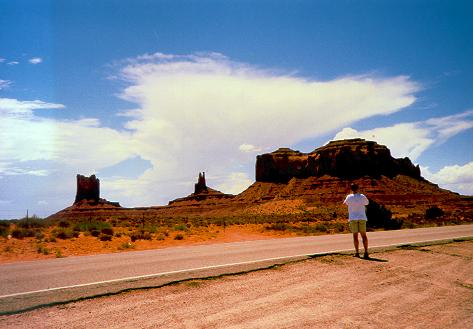

Page is just inside the state of Arizona.
The first sign of Page is three tall chimneys, releasing thin
pencils of smoke: not the billowing smoke one sees in colder climates,
but a thin trickle of smoke, like an upside down view of a thin
trickle of water running from a tap. It is almost as though the smoke
can't manage to billow in the oven.
As we get closer, the town takes
the appearance of an industrial estate and a constellation of motels.
The town of Page was built to house the workers who built the Glen
Canyon Dam, a monstrous construction which plugs the second largest
artificial lake in the USA. We have come here specifically to see this
feat of engineering prowess which, like the skyscrapers of Manhattan,
were built by hard labour with what seems like primitive technology
today.
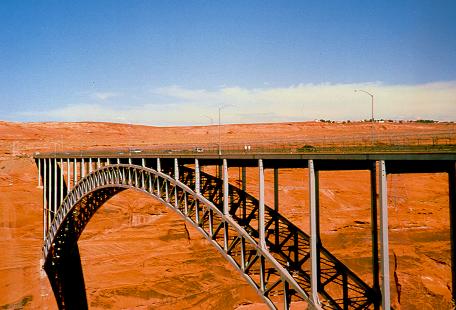


The dam is built on sandstone which is about 25% porous. It is anchored deep into the rock on either side. Holes are drilled to relieve the water pressure and bolts are attached to prevent the planes of weak sandstone from flaking off. The marvellous feat of construction is yet another symbol of the audacity of American engineering, surely the greatest building nation of the world.
On the way from Page to the motel we learn of a lake where it is
possible to swim. It is called Lone Rock. Even as we climb out of the
Lake Powell valley, with setting sun glaring in our line of sight, we
see the single mound of sandstone poking out of nowhere. It seems to
be an ideal location for a picnic dinner. The moon is almost full, the
sky clear and Lone Rock is supposed to have a sandy beach and warm
water. As we drive in, it becomes clear the Lone Rock is a misnomer:
it is The Rock That Used To Be Alone, but has plenty of company
now. The beach is choc-a-block with RVs (residential vehicles, or
mobile homes) and every manner of car and camping apparatus. Power
boats and fishing boats, even a fake steam boat seem to fill the
lake. Only a small area of the beach between toilet facilities and an
enclosure of the water is roped off. Fortunately, this area is
completely empty. Americans presumably prefer their mobile homes than
the beach itself. (So why are they here?) We park our cars close by
and walk down to the sound of gently lapping waves, not completely
overshadowed by power boats, powerskis, generators and shouting. The
water is warm and inviting and the I venture out into the lapping
waves. This is Navajo country and the moon guides my path. The sand is
soft and ribbed in velvet ripples under the clear water. A dog lopes
towards me but fails to penetrate my bubble of distraction.
Gradually, the sun falls and Venus emerges, a phosphorus flame on a
lilac sky. We have already been through Mars today in Monument Valley,
so this seems a fitting tribute. Campfires start to glow and the
disturbances on the lake subside. The last embers of the scorching day
ebb, leaving orange and mauve streaks punctuated by the occasional
cloud. As the light fades and the bluish moonlight takes over, we see
silent lightning storms blaze with crimson fire on the horizon, far
across the lake. The warm wind begins to pick up.
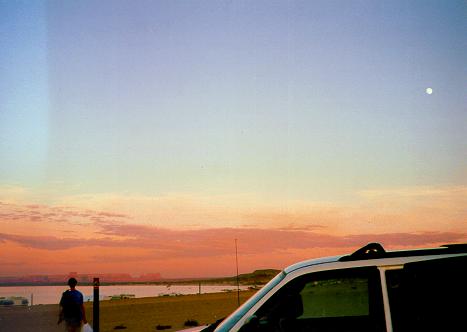
As we leave, it is quite dark and a moment of panic sets in as I am unable to get the key in the ignition. The steering lock has kicked in. In my mind Homer Simpson appears: `Doh! Stupid car security!'. Back at our motel (pleasant rooms in attractive surrounding, which means well kept rooms in a car junk yard in the desert) we crash for the night. In the morning, we return to the lake for a morning swim and breakfast on the beach. The temperature is already almost intolerable at 10:00 am and people are swimming and racing their dune buggies on the grassy dunes behind us. During the day, the lake looks like a Mediterranean resort: deep blue water and cloud pockered blue sky.
After breakfast we drive to Kanab (kebab), a middle to nowhere. A middle whose most outstanding attribute is a row of motels. We continue on to Panguitch (penguin) which is to be our base for visiting Bryce Canyon. A grocery store displays the excellent sign:
GOT MILK WE DO
in bold if not well-placed lettering. On seeing this, I chortled like an idiot, but I have since seen the same expression in San Francisco for something other than milk. This is real Americanese. Whilst (after 5 minutes) I understood what it actually meant, I am still unable to find an adequate translation into English. "Do you have milk? We do!", or "If you would like some milk, kind sir or madam, do please drop in won't you..." or "We have milk if you need some, and probably some other things as well which do not beg your attention to quite the extent that milk possibly might..." Perhaps it is to be read with the voice of Yoda, "Hmmm. Got milk, we do. Yes. Never a Jedi you will be, if not milk you have!"" I have noticed that Americans have replaced the verb "to have" with "to get". In other words: "Yes, could I have a cup of tea please" becomes: "Ya, could I get some tea?" which to English ears seems to mean "Ya, could I go and fetch some tea from somewhere", to which one might reply "If you want to, good American, sir". The lack of humility should, incidentally, not necessarily be confused with impoliteness, as it often is in Europe: it is simply the bare skeleton of intent ripped from fleshy irrelevant protocol and restated in words of preferably no more than three letters. The TLA of USA. Americans also abhor adverbs, and seem to replace them with the corresponding adjectives at any available opportunity. So, whereas in England one would say: "How are you?" and reply "Very (really) well, thanks", in American one must say: "Real good". Real good. I am real. I am good. Yeah, well, let's see what Santa has to say about that!
Anyway, dairy products notwithstanding, we check into the Best Western motel and indulge in a Jacuzzi and a swim in the pool before dragging our chlorinated wrinkles back for an evening trip to Bryce canyon. It's amazing what you can do with bubbles in a swim suit. Bryce canyon turns out to be a spectacle beyond belief: a fairy-tale world of red limestone (more like chalk) forming needles (or hoodoos) which would make a convincing set for a science fiction movie. Micro-stalactites run down rock faces where water has tricked out from its phreatic captivity, and towers of eroded rock almost resemble rows of chess pieces, lined up on the tops of cliffs. It all seems hopelessly fragile. I want to shoo away the tourists and hold my breath. Instead we follow a winding path downward, like in Journey To The Centre Of The Earth, taking us into narrow passages where tall trees eke out an existence on nothing but the chalky dust, until they grow so tall that their roots can no longer rely on the mechanical strength of the soil and they topple.
I cannot begin to describe the wonder of Bryce canyon. It is
probably quite unlike anything else on Earth. If the canyon lands
seems to have buried some gigantic fingers in quicksand, Bryce canyon
seems to have grown quite organically. It could be made of deep sea
thermal vents from a long evaporated sea, or be a petrified forest or
coral reef. It's not that I feel like a fish descending into the
canyons, no, it's more like being on the set of a Dr Who episode (say,
Logopolis), where the rock might transmogrify into something very
weird at any moment, and it wouldn't surprise me to find a fish
floating in the air down there. This is another world. It is alien.
If I had been E. von Daniken I would have chosen Bryce Canyon as
evidence of extra terrestrial intervention rather than the scratches in the
Mexican desert. Pictures do not do this place justice.

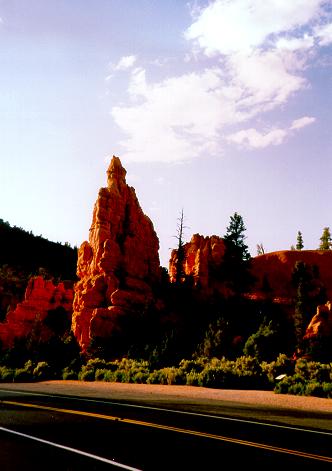

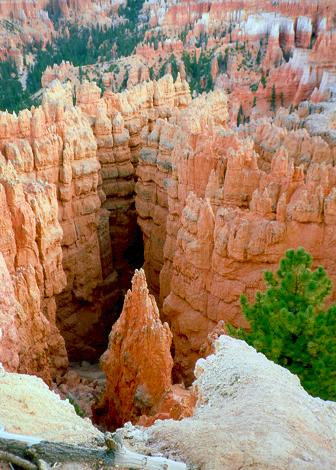
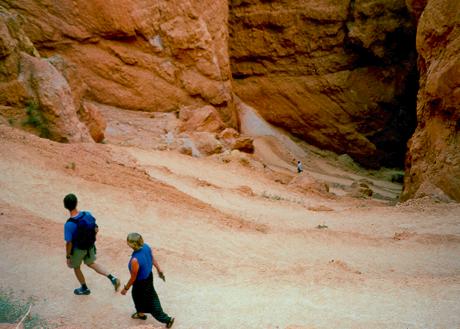
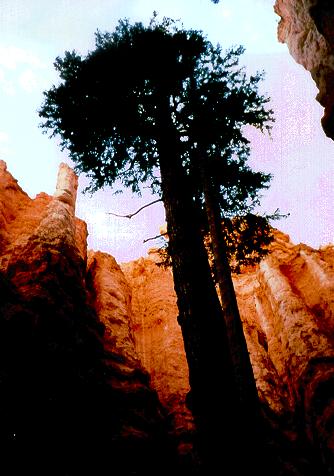

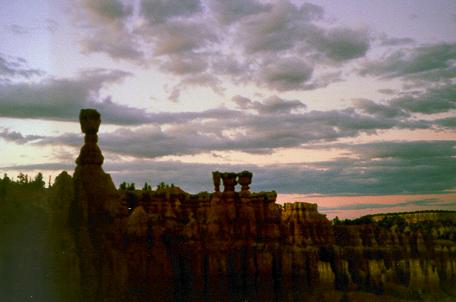
As dusk falls, we drive up to fairy-tale canyon, a lookout point over Bryce. The scene looks like a picture by Tim White from the cover of a fantasy book. The near full moon casts a surreal glow over the pillars below from our look out. We have been told to expect the meteor shower of the century tonight, but all we see is perhaps three events before we start to freeze for the first time in a week.
The next day, we part company with Claudia and Werner. They are returning to Provo, while we shall continue on to catch a flight home.
After a long day's drive trough Zion national park, almost running
out of petrol/gas (gas is a TLA or petrol) close to our goal, we
arrive in a new city. I find myself inside a luxuriously
air-conditioned room, overlooking an airport, on the 12th floor of a
gigantic pyramid. As I look out of the tinted, and tilted window,
ignoring the heiroglyphs on the wall, I see the back of a huge sphinx
and Cleopatra's needle. If this were not strange in itself, a twist of
the head reveals the Statue of Liberty and the top of the Chrysler
Building, presumably all in polystyrene. This could only be one place,
more Disney than Disney: yup, 't's Las Vegas.



Our refuelled 4x4 cuts through four lanes of traffic to double back across the freeway. Standard orbit around some weird planet we can just about make out. Then we seem to get mired in a gravitational anomaly. We inch our way through neon lit traffic chaos, in the hot light of day, past every bizarre chimera that was ever cast in Plaster of Vegas. The heat of Las Vegas is worse than anything hitherto. Perhaps it is enhanced by the millions of watts of heat which must be expelled by the air conditioners of every artificial space in sight. A vast self-illuminated sign advertises the Star Trek experience.
Looking for a room, we dock at New York! New York! But it's completely full. It's also completely huge and we get completely lost amongst the rows of gambling gizmos. Someone points us to an exit and tells us to head for the Luxor, so we find a mono-rail which takes us to the door. The entrance is guarded by Jackals and sarcophagi, but somehow we make it. The Luxor is a habitable `M' class hotel, so we book rooms and head back to collect our shuttle from the car park at New York! New York! A slight change of orbit and we're back. We struggle again through row upon row of one-armed bandits and fruit machines, casino tables, roulette, black-jack, and take an `inclinator' (not elevator) diagonally up and along the giant hollow pyramid. From the doorway of room 12131 we look down on the interior, filled with row upon row of casino chaos, cafes and restaurants, bands and frankly every other imaginable affront to ancient Egypt.
The pyramid has a stack of lasers at its summit which fire beams of white light straight up into the heavens. Someone tells us that it is the only laser on Earth visible on the Moon. I'm not sure how though, since it's not pointing anywhere near the Moon. So much for American marketing. Smaller chaser lights run up and down the edges, as though channeling the power of the Nevada desert's mystical ley lines up to the focused beam for passing space travellers to see. Come to Vegas! Or perhaps it is merely an internet connection to the Casinos of Orion's belt. Whatever. We go out into the soupy night air to get a Taxi to the Las Vegas Hilton, where the Star Trek Experience is to be found. I would love to describe that experience, but it's classified.
In the morning Nils and I are heading towards Oakland and Susanne is on her way back to Europe. As we leave Las Vegas, I turn to a middle aged black woman beside me, on the flight, and say: "It's good to be getting out of the heat of Vegas!". She looks at me strangely at first and then eventually she seems to find an understanding and proclaims: "Praise Jesus!". Perhaps another time.
In Oakland, Marit and Tai are waiting for us at the airport and we head back to their apartment in Kensington to catch up. We spend the week wandering around the Bay Area, watching movies (Chicken Run, The Cell and Cecil B. Demented), shopping books and CDs, and embarking on a culinary marathon of the Bay Area's exotic restaurants. At one point, we find our selves in Sauselito, walking along the coast looking for a couple of Humpbacked Whales named George and Gracie, or was that something I dreamt? A better option turns out to be stopping at the North Sea restaurant, where they have fabulous Dim Sum. Then it's over the Golden Gate Bridge (watch out for the F.O.G.) and we stop in Golden Gate Park: a huge parkland maybe four of five miles long, on the San Francisco peninsula. Eventually we emerge from the park, with a windmill on our right (looks functional) to fantastic view of the ocean. A white sandy beach stretches out in both directions to the distant rocks. Freezing waves roll in, their beauty a veil over the dangerous rip-tide which can wash away the unwary.
We end our stay in Berkeley with a wine and cheese evening, which leaves me heaving over the toilet in the morning like a university student. That's what you get for straying into hot alcohol-free desert country and getting out of practice. Fortunately a nice cup of tea and an English muffin makes everything hunky dory again, so it's back to SFO to stand in ridiculous queues once more. We're on our way home.
After a brief stop to pick up chocolate at London Heathrow, we arrive back in Norway. It has just rained, something I had almost forgotten, and 15 degrees is pleasantly cool. Still, it is strange to be back. Everything looks modern, clean and sedated, compared to a livelier more vital America. Like the space cylinder in Arthur C. Clarke's Rendezvous With Rama: a brand new environment, but no one here to enjoy it. I am anxious to get home now and view the damage while I've been away. I had thought my plants would be dead, but they seem to be thriving better than ever without my attentions. I'm not sure whether I should be pleased or insulted. I have only 550 mail messages from the three week trip and none of them are desperate. I seem to have gotten off lightly. The thought of resuming work doesn't appeal though.
I feel more restless than ever. But like it or not, it's back to the grind. Now that my sabbatical is starting I'll have to keep a low profile to avoid getting caught in the rut of College affairs, and plan my weaning from holiday to Researcher. It's going to take a while.
Postscript
The year 2000 has been full of surprises. Now it is November 20th and the latest has turned out to be rain. The highest rainfall for 100 years has turned Oslo's main river, Aker into a tumultuous jaccuzzi, blasting through the town with a casual disregard for its banks. I have never seen water move so fast. It is white water on drugs. It looks like film run on fast forward. The seething and relentless folding of tonnes and tonnes of high powered water, not merely falling at the old Mill waterfall (Mølla), but blasting like an explosion whose vapourous debris rises almost to the top of the high rise flats which stand along side. Its seems impossibly fast, indefatigably infinite. Where is it coming from? The water level, even on the flats is some four times its usual height, filling the walkways along side as though they were aquaducts. And the rain keeps falling. Norway is producing ten times the amount of hydro-electric power it usually does. Something positive for the rain whiners.
The days are dark now, and the rain is a constant light drizzle. It is good to be on high ground. I have just returned from the Netherlands, a country who knows what flood means. While I was there, I saw England under a sea of the broken banks of the river Ouse. Rain has gone mad here. The water is coming...